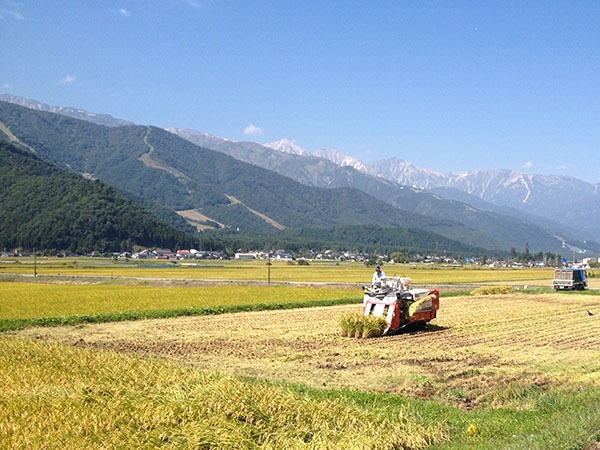
Most winter visitors only see Hakuba covered in white and are surprised to know that the town is not only an international resort but also a farming village with rice as its main crop.
Rice has traditionally played a major role in Japanese society and is an essential part of the culture. In the Japanese language itself, the word for cooked rice, “gohan” has a further meaning of “food” or “a meal”. People will say they’ve had their “rice” (“gohan”) even when they’ve had noodles or a sandwich! Breakfast is “asa-gohan” (“morning rice”), even if you have a Japanese doorstep slice of toast. The same goes for whatever you have for lunch (“hiru-gohan”) and dinner (“ban-gohan”).
Virtually all of the rice grown and consumed in Japan is sticky, short-grain Japonica rice. The stickiness allows it to be formed into the most characteristic of Japanese dishes, sushi, and perhaps Japan’s ultimate comfort food, onigiri rice balls. Almost all of Japan’s rice is grown according to wetland cultivation thanks to Japan’s wet climate and the higher yields it produces. Rice cultivation was introduced into Japan by settlers from the Korean Peninsula in the late Jomon Period (around 1500BC onwards). Even then, it took many centuries to develop strains that could be grown in the colder, northern parts of Japan and for rice to replace grains like millet and buckwheat that were more commonly eaten. Readers who have seen the “Seven Samurai” will recall the scene early in the movie where the villagers eat millet and use their best rice to recruit the Samurai. Rice was not eaten at most meals by ordinary Japanese people until the Twentieth Century.
Historically, wet rice cultivation was a labour-intensive task carried out by villagers working together. The digging of and maintenance of irrigation trenches were also carried out collectively, as they are to this day. Aerial photos of Hakuba from the 1970s still show hundreds of tiny paddies built in terraces following the curved contours of the land. The larger, rectangular paddies you can see today are the result of bulldozing the fields. Such larger paddies allow the fields to be worked with machines like planters and combine harvesters.
Typical preparation of a paddy includes ploughing the field (ta-okoshi), sealing the boundary walls of the paddy, and then flooding the field. A finer, wet ploughing (shiro-kaki) is then carried out to flatten the field and ensure the water level can be kept even. Many readers will know that the name “Hakuba” means the “white horse”. It is also common knowledge that this derives from Mt. Shirouma (also “white horse”), the mountain above town where the image of a horse appears in the rock as the snow melts in spring. What is less commonly known is that the horse image, which is dark rock on white snow, was originally called the “shiro-kaki uma”, the “ploughing horse”. Locals would use the appearance of the horse as an indicator that it was time to prepare the fields for planting. This name was misheard as “shiro-uma” and it is this “white horse” name that stuck.
Most rice grown in Hakuba today is a strain called “Akita-Komachi”, a modern variety developed in the north of Japan. Compared to the well-known “Koshi-Hikari” strain grown in neighbouring Niigata, “Akita-Komachi” is more resistant of the cold and produces stronger stalks, a useful feature in windy Hakuba. The odd small area is still used to grow ancient strains of purple rice which is usually eaten mixed with regular white rice. Ancient coloured varieties are also used to produce “tanbo art”, huge and sometimes very detailed pictures that are carefully planted and appear in the fields (tanbo) as the rice heads develop. If you are in Hakuba in early summer, you should be able to see one somewhere along the Olympic Road. Some parts of rural Japan go crazy with their art producing beautiful depictions of samurai and geisha spanning multiple fields.
Aside from simple rice, be sure to try rice wine (sake), rice cakes (mochi), and rice crackers (sembei). In all its forms, rice is nice!
Most Japanese white rice (hakumai) is the short grain variety. The rice is polished which removes the outer skin. Because of the sticky texture, the rice is easy to pick up with chopsticks and with it’s mild taste makes it a perfect accompaniment to almost any food.
Japan’s most celebrated alcoholic drink, sake is brewed by fermenting the rice. Surprisingly sake is traditionally not drunk with rice. Sake is clear with a slightly sweet taste and an alcohol content of about 15%. It can be served hot or cold.
To make the perfect rice you need an electric rice cooker. These have been around since 1995 and every household in Japan will have one. Not only rice can be cooked, but also stewed and steamed dishes.
Mochi is a type of Japanese rice cake. Very chewy and sweet, it takes some effort to make, but it is worth the effort and indeed, making mochi is both an art form and a tradition. It is often referred to as “o-mochi”, an honorific added to show that this is considered a sacred food. Mochi is an indispensable part of New Year celebrations in Japan
HAKUBA DINING GUIDE WINTER 2013-2014

Leave a Reply